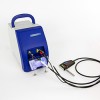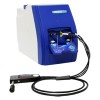
Art & Archaeology
Art and archaeological conservation and study can prove to be extremely difficult due to years of decay and neglect, making
it hard to create an accurate history of artifacts. Portable Raman spectroscopy, partnered with techniques such as X-ray fluorescence
and diffuse reflectance has gained wide acceptance as a technique for studying and identifying art and artifacts from past decades.
These techniques have uncovered discoveries in prehistoric paintings on rock walls, such as discerning what the images are and providing
crucial information to scientifically date the crusts and rock art itself. Raman can be used to study organics and inorganics – both are
present in paints, pigments, and architectural materials. Portability allows the user to maintain the integrity of important heritage
sites, and is in line with requirements of conservationists working to understand the origins of objects without the need to move them,
and with minimal invasion.
Enhanced Raman technology has allowed us to study the results of biological activity in ancient environments and human cultural heritage
as reflected in art and artifacts. Raman spectroscopy also serves as an important tool in identifying art forgeries, as natural and synthetic
pigments and can be identified and differentiated.


